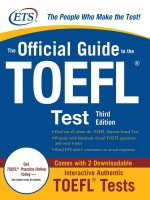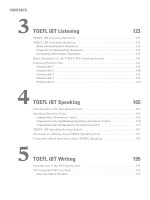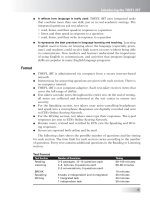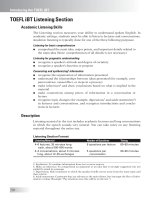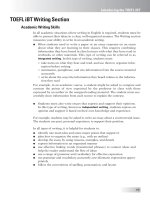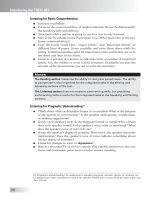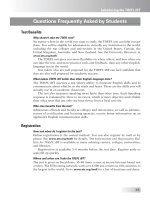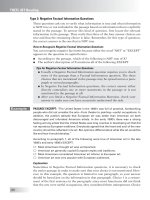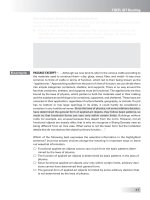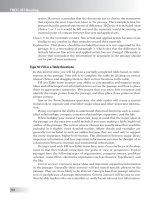The official guide to the toefl ibt third edition part 11 potx
Bạn đang xem bản rút gọn của tài liệu. Xem và tải ngay bản đầy đủ của tài liệu tại đây (109.45 KB, 7 trang )
before
Basilosaurus
. The fossil luckily includes a good portion of the hind legs. The
legs were strong and ended in long feet very much like those of a modern pinniped.
The legs were certainly functional both on land and at sea. The whale retained a tail
and lacked a fluke, the major means of locomotion in modern cetaceans. The structure
of the backbone shows, however, that
Ambulocetus
swam like modern whales by
moving the rear portion of its body up and down, even though a fluke was missing.
The large hind legs were used for propulsion in water. On land, where it probably bred
and gave birth,
Ambulocetus
may have moved around very much like a modern sea
lion. It was undoubtedly a whale that linked life on land with life at sea.
1. Fluke: the two parts that constitute the large triangular tail of a whale
2. Blowhole: a hole in the top of the head used for breathing
It should be obvious that cetaceans—whales, porpoises, and dolphins—are mammals.
They breathe through lungs, not through gills, and give birth to live young. Their
streamlined bodies, the absence of hind legs, and the presence of a fluke
1
and blow-
hole
2
cannot disguise their affinities with land-dwelling mammals. However, unlike the
cases of sea otters and pinnipeds (seals, sea lions, and walruses, whose limbs are
functional both on land and at sea), it is not easy to envision what the first whales
looked like. Extinct but already fully marine cetaceans are known from the fossil
record. How was the gap between a walking mammal and a swimming whale
bridged? Missing until recently were fossils clearly intermediate, or transitional, be-
tween land mammals and cetaceans.
1. Fluke: the two parts that constitute the large triangular tail of a whale
2. Blowhole: a hole in the top of the head used for breathing
Directions:
Mark your answer by filling in the oval next to your choice.
61
TOEFL iBT Reading
1. In paragraph 1, what does the author
say about the presence of a blow-
hole in cetaceans?
ɕ
It clearly indicates that cetaceans are
mammals.
ɕ
It cannot conceal the fact that ceta-
ceans are mammals.
ɕ
It is the main difference between
cetaceans and land-dwelling mam-
mals.
ɕ
It cannot yield clues about the ori-
gins of cetaceans.
2. Which of the following can be in-
ferred from paragraph 1 about early
sea otters?
ɕ
It is not difficult to imagine what they
looked like.
ɕ
There were great numbers of them.
ɕ
They lived in the sea only.
ɕ
They did not leave many fossil
remains.
P
A
R
A
G
R
A
P
H
1
TOEFL iBT Reading
Another major discovery was made in Egypt in 1989. Several skeletons of another
early whale,
Basilosaurus
, were found in sediments left by the Tethys Sea and now
exposed in the Sahara desert. This whale lived around 40 million years ago, 12 million
years after
Pakicetus
. Many incomplete skeletons were found but they included, for
the first time in an archaeocyte, a complete hind leg that features a foot with three tiny
toes. Such legs would have been far too small to have supported the 50-foot-long
Basilosaurus
on land.
Basilosaurus
was undoubtedly a fully marine whale with possi-
bly nonfunctional, or vestigial, hind legs.
The fossil consists of a complete skull of an archaeocyte, an extinct group of ancestors
of modern cetaceans. Although limited to a skull, the
Pakicetus
fossil provides
precious details on the origins of cetaceans. The skull is cetacean-like but its jawbones
lack the enlarged space that is filled with fat or oil and used for receiving underwater
sound in modern whales.
Pakicetus
probably detected sound through the ear opening
as in land mammals. The skull also lacks a blowhole, another cetacean adaptation for
diving. Other features, however, show experts that
Pakicetus
is a transitional form be-
tween a group of extinct flesh-eating mammals, the mesonychids, and cetaceans. It
has been suggested that
Pakicetus
fed on fish in shallow water and was not yet
adapted for life in the open ocean. It probably bred and gave birth on land.
62
P
A
R
A
G
R
A
P
H
4
3. The word precious in the passage
is closest in meaning to
ɕ
exact
ɕ
scarce
ɕ
valuable
ɕ
initial
4.
Pakicetus
and modern cetaceans
have similar
ɕ
hearing structures
ɕ
adaptations for diving
ɕ
skull shapes
ɕ
breeding locations
5. The word It in the passage refers to
ɕ
Pakicetus
ɕ
fish
ɕ
life
ɕ
ocean
6. The word exposed in the passage
is closest in meaning to
ɕ
explained
ɕ
visible
ɕ
identified
ɕ
located
7. The hind leg of
Basilosaurus
was
a significant find because it showed
that
Basilosaurus
ɕ
lived later than
Ambulocetus natans
ɕ
lived at the same time as
Pakicetus
ɕ
was able to swim well
ɕ
could not have walked on land
8. It can be inferred that
Basilosaurus
bred and gave birth in which of the
following locations?
ɕ
On land
ɕ
Both on land and at sea
ɕ
In shallow water
ɕ
In a marine environment
P
A
R
A
G
R
A
P
H
3
An even more exciting find was reported in 1994, also from Pakistan. The now extinct
whale
Ambulocetus natans
(“the walking whale that swam”) lived in the Tethys Sea
49 million years ago. It lived around 3 million years after
Pakicetus
but 9 million before
Basilosaurus
. The fossil luckily includes a good portion of the hind legs. The legs were
strong and ended in long feet very much like those of a modern pinniped. The legs
were certainly functional both on land and at sea. The whale retained a tail and lacked
a fluke, the major means of locomotion in modern cetaceans. The structure of the
backbone shows, however, that
Ambulocetus
swam like modern whales by moving
the rear portion of its body up and down, even though a fluke was missing. The large
hind legs were used for propulsion in water. On land, where it probably bred and gave
birth,
Ambulocetus
may have moved around very much like a modern sea lion. It was
undoubtedly a whale that linked life on land with life at sea.
63
TOEFL iBT Reading
9. Why does the author use the word
luckily in mentioning that the
Ambu-
locetus natans
fossil included hind
legs?
ɕ
Fossil legs of early whales are a rare
find.
ɕ
The legs provided important infor-
mation about the evolution of
cetaceans.
ɕ
The discovery allowed scientists to
reconstruct a complete skeleton of
the whale.
ɕ
Until that time, only the front legs of
early whales had been discovered.
10. Which of the sentences below best
expresses the essential information
in the highlighted sentence in the
passage?
Incorrect
choices change
the meaning in important ways or
leave out essential information.
ɕ
Even though
Ambulocetus
swam by
moving its body up and down, it did
not have a backbone.
ɕ
The backbone of
Ambulocetus
,
which allowed it to swim, provides
evidence of its missing fluke.
ɕ
Although
Ambulocetus
had no fluke,
its backbone structure shows that it
swam like modern whales.
ɕ
By moving the rear parts of their
bodies up and down, modern whales
swim in a different way from the
way
Ambulocetus
swam.
11. The word propulsion in the passage
is closest in meaning to
ɕ
staying afloat
ɕ
changing direction
ɕ
decreasing weight
ɕ
moving forward
P
A
R
A
G
R
A
P
H
5
TOEFL iBT Reading
Extinct but already fully marine cetaceans are known from the fossil record.
7
How
was the gap between a walking mammal and a swimming whale bridged?
7
Missing
until recently were fossils clearly intermediate, or transitional, between land mammals
and cetaceans.
7
Very exciting discoveries have finally allowed scientists to reconstruct the most
likely origins of cetaceans.
7
In 1979, a team looking for fossils in northern Pakistan
found what proved to be the oldest fossil whale.
12. Look at the four squares [
7
] that indicate where the following sentence can be
added to the passage.
This is a question that has puzzled scientists for ages.
Where would the sentence best fit?
ɕ
Extinct but already fully marine cetaceans are known from the fossil record. This
is a question that has puzzled scientists for ages. How was the gap between a
walking mammal and a swimming whale bridged?
7
Missing until recently were
fossils clearly intermediate, or transitional, between land mammals and
cetaceans.
7
Very exciting discoveries have finally allowed scientists to reconstruct the
most likely origins of cetaceans.
7
In 1979, a team looking for fossils in northern
Pakistan found what proved to be the oldest fossil whale.
ɕ
Extinct but already fully marine cetaceans are known from the fossil record.
7
How was the gap between a walking mammal and a swimming whale bridged?
This is a question that has puzzled scientists for ages. Missing until recently
were fossils clearly intermediate, or transitional, between land mammals and
cetaceans.
7
Very exciting discoveries have finally allowed scientists to reconstruct the
most likely origins of cetaceans.
7
In 1979, a team looking for fossils in northern
Pakistan found what proved to be the oldest fossil whale.
ɕ
Extinct but already fully marine cetaceans are known from the fossil record.
7
How was the gap between a walking mammal and a swimming whale bridged?
7
Missing until recently were fossils clearly intermediate, or transitional, be-
tween land mammals and cetaceans.
This is a question that has puzzled scientists for ages. Very exciting discov-
eries have finally allowed scientists to reconstruct the most likely origins of
cetaceans.
7
In 1979, a team looking for fossils in northern Pakistan found what
proved to be the oldest fossil whale.
ɕ
Extinct but already fully marine cetaceans are known from the fossil record.
7
How was the gap between a walking mammal and a swimming whale bridged?
7
Missing until recently were fossils clearly intermediate, or transitional, be-
tween land mammals and cetaceans.
7
Very exciting discoveries have finally allowed scientists to reconstruct the
most likely origins of cetaceans. This is a question that has puzzled scientists for
ages. In 1979, a team looking for fossils in northern Pakistan found what proved
to be the oldest fossil whale.
64
P
A
R
A
G
R
A
P
H
1
65
TOEFL iBT Reading
13–14. Directions:
An introductory sentence for a brief summary of the passage is
provided below. Complete the summary by selecting the THREE answer choices
that express the most important ideas in the passage. Some answer choices do
not belong in the summary because they express ideas that are not presented in
the passage or are minor ideas in the passage.
This question is worth 2 points.
This passage discusses fossils that help to explain the likely origins of
cetaceans— whales, porpoises, and dolphins.
b
b
b
Answer Choices
1. Recent discoveries of fossils have
helped to show the link between
land mammals and cetaceans.
2. The discovery of
Ambulocetus
natans
provided evidence for a
whale that lived both on land and at
sea.
3. The skeleton of
Basilosaurus
was
found in what had been the Tethys
Sea, an area rich in fossil evidence.
4.
Pakicetus
is the oldest fossil whale
yet to be found.
5. Fossils thought to be transitional
forms between walking mammals
and swimming whales were found.
6.
Ambulocetus
’ hind legs were used
for propulsion in the water.
PRACTICE SET 1 ANSWERS AND EXPLANATIONS
1.
ᕢ
This is a Factual Information question asking for specific information that
can be found in paragraph 1. Choice 2 is the best answer. It is essentially a
rephrasing of the statement in paragraph 1 that blowholes cannot disguise
cetaceans’ affinities with other mammals. The other three choices are refuted,
either directly or indirectly, by that paragraph.
2.
ᕡ
This is an Inference question asking for information that can be inferred
from paragraph 1. Choice 1 is the best answer because paragraph 1 says that
sea otters are unlike early mammals whose appearances are not easy to imag-
ine. By inference, then, the early appearance of sea otters must be easy (or not
difficult) to imagine.
3.
ᕣ
This is a Vocabulary question. The word being tested is precious. It is high-
lighted in the passage. The correct answer is choice 3, “valuable.” Anything
that is precious is very important and therefore valuable.
4.
ᕣ
This is a Factual Information question asking for specific information that
can be found in the passage. Choice 3 is the best answer. Paragraph 3
describes the differences and similarities between Pakicetus and modern
TOEFL iBT Reading
cetaceans. Sentence 3 of that paragraph states that their skulls are similar.
The other three choices describe differences, not similarities.
5.
ᕡ
This is a Reference question. The word being tested is It. That word is
highlighted in the passage. This is a simple pronoun referent item. Choice 1,
“Pakicetus“ is the correct answer. The word It here refers to a creature that
probably bred and gave birth on land. Pakicetus is the only one of the choices
to which this could apply.
6.
ᕢ
This is a Vocabulary question. The word being tested is exposed. It is high-
lighted in the passage. The correct answer is choice 2, “visible.” Exposed
means “uncovered.” A skeleton that is uncovered can be seen. Visible means
“can be seen.”
7.
ᕤ
This is a Factual Information question asking for specific information that
can be found in the passage. Choice 4 is the best answer because it is the only
detail about the skeleton of Basilosaurus mentioned in paragraph 4, meaning
that it is significant. Choice 1 is true, but it is not discussed in the detail that
choice 4 is, and does not represent the significance of the discovery. Choice 3
is not mentioned, and choice 2 is not true.
8.
ᕤ
This is an Inference question asking for a conclusion that can be drawn
from the entire passage. Choice 4 is the best answer based on the last sen-
tence of paragraph 4, which describes Basilosaurus as a fully marine whale.
That implies that everything it did, including breeding and giving birth, could
have been done only in a marine environment.
9.
ᕢ
This is an Inference question asking for a conclusion that can be drawn
from the passage. Paragraph 5 explains that this discovery provided impor-
tant information to scientists that they might not have been able to obtain
without it. Therefore, you can infer that the discovery was a “lucky” one. The
passage offers no support for the other choices. Therefore, choice 2 is the best
answer.
10.
ᕣ
This is a Sentence Simplification question. As with all of these items, a
single sentence in the passage is highlighted:
The structure of the backbone shows, however, that Ambulocetus swam like mod-
ern whales by moving the rear portion of its body up and down, even though
a fluke was missing.
Choice 3 is the best answer because it contains all of the essential informa-
tion in the highlighted sentence. Choice 1 is not true because Ambulocetus did
have a backbone. Choice 2 is not true because the sentence says that the back-
bone showed how the Ambulocetus swam, not that it was missing a fluke.
Choice 4 is untrue because the sentence states that Ambulocetus and modern
whales swam in the same way.
11.
ᕤ
This is a Vocabulary question. The word being tested is propulsion. It is
highlighted in the passage. Choice 4, “moving forward” is the best answer
because it means “the action of propelling.” The whale in the sentence used
its hind legs to push itself forward in the water.
66
67
TOEFL iBT Reading
12.
ᕢ
This is an Insert Text question. You can see the four black squares in para-
graphs 1 and 2 that represent the possible answer choices here.
Extinct but already fully marine cetaceans are known from the fossil record.
7
How
was the gap between a walking mammal and a swimming whale bridged?
7
Missing
until recently were fossils clearly intermediate, or transitional, between land mammals
and cetaceans.
7
Very exciting discoveries have finally allowed scientists to recon-
struct the most likely origins of cetaceans.
7
In 1979, a team looking for fossils in
northern Pakistan found what proved to be the oldest fossil whale.
The sentence provided is “This is a question that has puzzled scientists for
ages.” The correct place to insert it is at square 2.
The sentence that precedes square 2 is in the form of a rhetorical question,
and the inserted sentence explicitly provides a response to it. None of the
other sentences preceding squares is a question, so the inserted sentence can-
not logically follow any one of them.
13.
ᕡ ᕢ ᕥ
This is a Prose Summary question. It is completed correctly below.
The correct choices are 1, 2, and 5. Choices 3, 4, and 6 are therefore incorrect.
Directions:
An introductory sentence for a brief summary of the passage is provided
below. Complete the summary by selecting the THREE answer choices that express
the most important ideas in the passage. Some answer choices do not belong in the
summary because they express ideas that are not presented in the passage or are
minor ideas in the passage.
This question is worth 2 points.
This passage discusses fossils that help to explain the likely origins of
cetaceans—whales, porpoises, and dolphins.
b
Recent discoveries of fossils have helped to show the link between land
mammals and cetaceans.
b
The discovery of
Ambulocetus natans
provided evidence for a whale that
lived both on land and at sea.
b
Fossils thought to be transitional forms between walking mammals and
swimming whales were found.
Answer Choices
1. Recent discoveries of fossils have
helped to show the link between
land mammals and cetaceans.
2. The discovery of
Ambulocetus
natans
provided evidence for a
whale that lived both on land and
at sea.
3. The skeleton of
Basilosaurus
was
found in what had been the Tethys
Sea, an area rich in fossil evidence.
4.
Pakicetus
is the oldest fossil whale
yet to be found.
5. Fossils thought to be transitional
forms between walking mammals
and swimming whales were found.
6.
Ambulocetus
’ hind legs were used
for propulsion in the water.
